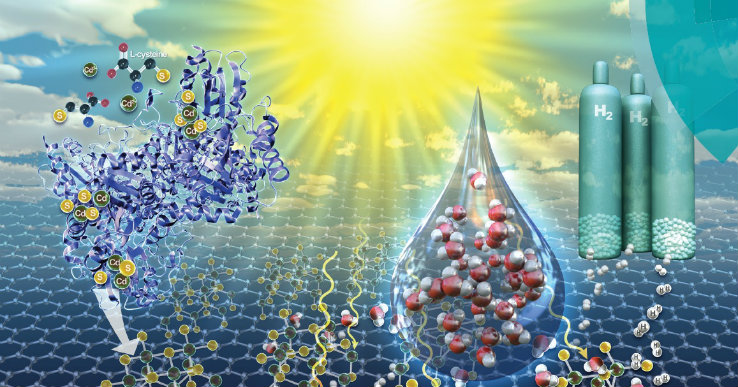Engineers at Lehigh University are the first to utilize a single enzyme biomineralization process to create a catalyst that uses the energy of captured sunlight to split water molecules to produce hydrogen. The synthesis process is performed at room temperature and under ambient pressure, overcoming the sustainability and scalability challenges of previously reported methods.
Solar-driven water splitting is a promising route towards a renewable energy-based economy. The generated hydrogen could serve as both a transportation fuel and a critical chemical feedstock for fertilizer and chemical production. Both of these sectors currently contribute a large fraction of total greenhouse gas emissions.
One of the challenges to realizing the promise of solar-driven energy production is that, while the required water is an abundant resource, previously-explored methods utilize complex routes that require environmentally-damaging solvents and massive amounts of energy to produce at large scale. The expense and harm to the environment have made these methods unworkable as a long-term solution.
Now a team of engineers at Lehigh University have harnessed a biomineralization approach to synthesizing both quantum confined nanoparticle metal sulfide particles and the supporting reduced graphene oxide material to create a photocatalyst that splits water to form hydrogen. The team reported their results in an article entitled: “Enzymatic synthesis of supported CdS quantum dot/reduced graphene oxide photocatalysts” featured on the cover of the August 7th issue of Green Chemistry, a journal of the Royal Society of Chemistry.
The paper’s authors include: Steven McIntosh, Professor in Lehigh’s Department of Chemical and Biomolecular Engineering, along with Leah C. Spangler, former Ph.D. student and John D. Sakizadeh, current Ph.D. student; as well, as Christopher J. Kiely, Harold B. Chambers Senior Professor in Lehigh’s Department of Materials Science and Engineering and Joseph P. Cline, a Ph.D. student working with Kiely.
“Our water-based process represents a scalable green route for the production of this promising photocatalyst technology,” said McIntosh, who is also Associate Director of Lehigh’s Institute for Functional Materials and Devices.
Over the past several years, McIntosh’s group has developed a single enzyme approach for biomineralization―the process by which living organisms produce minerals―of size-controlled, quantum confined metal sulfide nanocrystals. In a previous collaboration with Kiely, the lab successfully demonstrated the first precisely controlled, biological way to manufacture quantum dots. Their one-step method began with engineered bacterial cells in a simple, aqueous solution and ended with functional semiconducting nanoparticles, all without resorting to high temperatures and toxic chemicals. The method was featured in a New York Times article: “How a Mysterious Bacteria Almost Gave You a Better TV.”
“Other groups have experimented with biomineralization for chemical synthesis of nanomaterials,” says Spangler, lead author and currently a Postdoctoral Research Fellow at Princeton University. “The challenge has been achieving control over the properties of the materials such as particle size and crystallinity so that the resulting material can be used in energy applications.”
McIntosh describes how Spangler was able to tune the group’s established biomineralization process to not only synthesize the cadmium sulfide nanoparticles but also to reduce graphene oxide to the more conductive reduced graphene oxide form.
“She was then able to bind the two components together to create a more efficient photocatalyst consisting of the nanoparticles supported on the reduced graphene oxide,” says McIntosh. “Thus her hard work and resulting discovery enabled both critical components for the photocatalyst to be synthesized in a green manner.”
The team’s work demonstrates the utility of biomineralization to realize benign synthesis of functional materials for use in the energy sector.
“Industry may consider implementation of such novel synthesis routes at scale,” adds Kiely. “Other scientists may also be able to utilize the concepts in this work to create other materials of critical technological importance.”
McIntosh emphasizes the potential of this promising new method as “a green route, to a green energy source, using abundant resources.”
“It is critical to recognize that any practical solution to the greening of our energy sector will have to be implemented at enormous scale to have any substantial impact,” he adds.
This material is based on work supported by the National Science Foundation (NSF).





